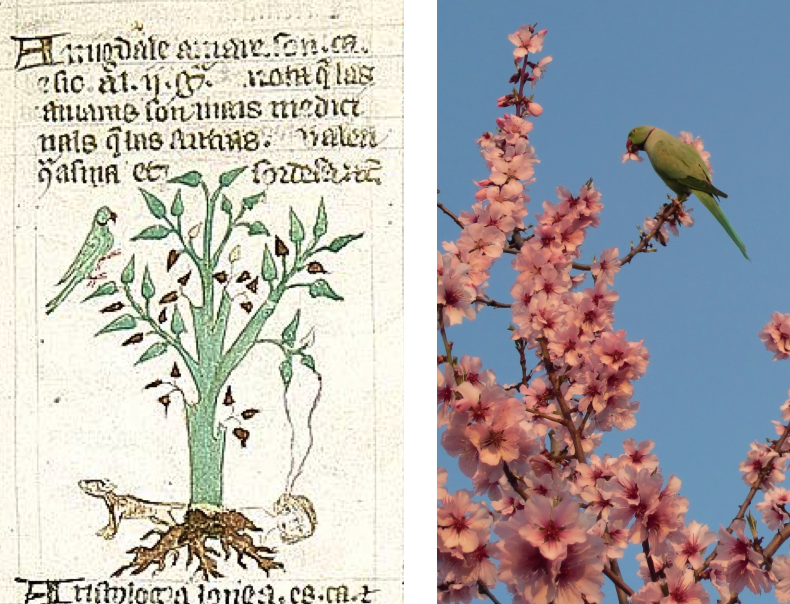7 January 2018
What are those eyes, faces, animals, dragons, demons, and other oddities added to plant drawings in herbal manuscripts? In medieval society, there were no encyclopedias, nature shows, or PDAs, and a very high proportion of the population was illiterate, so these added details served as memory aids to help the reader understand the plant.
Palatino 586, an herbal manuscript created around the same time as the VMS, has a large number of figural drawings associated with the plants, but they are hard to see due to the low resolution of the scans. Hopefully some day better scans will be available so we can fully appreciate their intricacy and significance. A few years ago, I did my best to read the text and interpret the drawings and was able to puzzle out some of the enigmatic additions.
This small selection of examples provides basic tips on interpreting the drawings.
Let’s start with one of the easier ones…
Page 10, Lower Left and Right
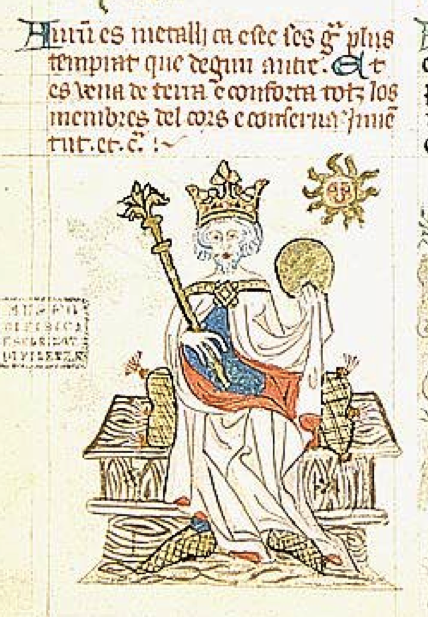 On page 10, the text introduces Auru’ (Aurum), which is Latin for gold. Underneath is a royal figure with gold scepter and crown. It was not uncommon for metals and minerals to be included in herbal texts, as some were used for medicinal purposes or as ingredients in composite formulae. In this case, the memory trigger is not medicinal uses, but common uses—the king holds a large gold coin, orb, or platter. The sun, suggesting a golden color or light, shines close by.
On page 10, the text introduces Auru’ (Aurum), which is Latin for gold. Underneath is a royal figure with gold scepter and crown. It was not uncommon for metals and minerals to be included in herbal texts, as some were used for medicinal purposes or as ingredients in composite formulae. In this case, the memory trigger is not medicinal uses, but common uses—the king holds a large gold coin, orb, or platter. The sun, suggesting a golden color or light, shines close by.
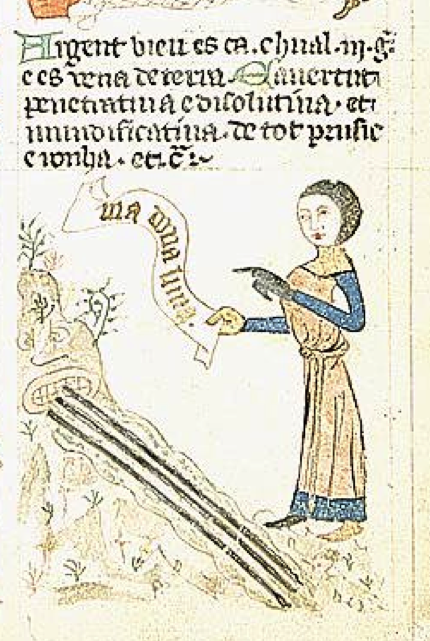 To fully understand this drawing, however, you have to look at the next one, which describes Argent (silver). It won’t surprise modern viewers to see gold and silver together, as they are both precious metals used for similar purposes, but in medieval times, there were additional reasons for pairing these metals and the drawing helps to explain this. We see a personified mountain, indicating that silver is an ore that must be mined, but the figure next to it is pointing to a scroll that refers to luna (the moon) because plants, metals, and minerals were considered to have governing bodies up in the heavens. They believed that gold and silver were ruled by the sun and the moon and shared some of their properties.
To fully understand this drawing, however, you have to look at the next one, which describes Argent (silver). It won’t surprise modern viewers to see gold and silver together, as they are both precious metals used for similar purposes, but in medieval times, there were additional reasons for pairing these metals and the drawing helps to explain this. We see a personified mountain, indicating that silver is an ore that must be mined, but the figure next to it is pointing to a scroll that refers to luna (the moon) because plants, metals, and minerals were considered to have governing bodies up in the heavens. They believed that gold and silver were ruled by the sun and the moon and shared some of their properties.
Page 11 Top Left and Right
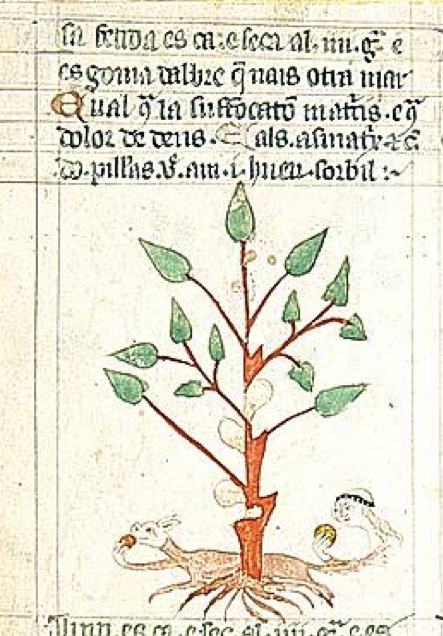 On page 11 is a slightly more enigmatic drawing—a woman and a dog consuming round objects next to a plant with lumps on the stem. Reading the text we see [A]sa fetida, now known as Ferula asafoetida. This is a large resinous herb that exudes sap from the lower stem and root. Dried and crushed, the resin has long been used as a flavoring agent and medicinal substance. Thus, the illustration indicates that this is consumed by humans, but why the dog? As it turns out, in both eastern and western medicine, asafoetida was used to treat digestive difficulties in dogs and horses. It can be found as a remedy in historic copies of Materia Medica that were adapted for veterinary use.
On page 11 is a slightly more enigmatic drawing—a woman and a dog consuming round objects next to a plant with lumps on the stem. Reading the text we see [A]sa fetida, now known as Ferula asafoetida. This is a large resinous herb that exudes sap from the lower stem and root. Dried and crushed, the resin has long been used as a flavoring agent and medicinal substance. Thus, the illustration indicates that this is consumed by humans, but why the dog? As it turns out, in both eastern and western medicine, asafoetida was used to treat digestive difficulties in dogs and horses. It can be found as a remedy in historic copies of Materia Medica that were adapted for veterinary use.
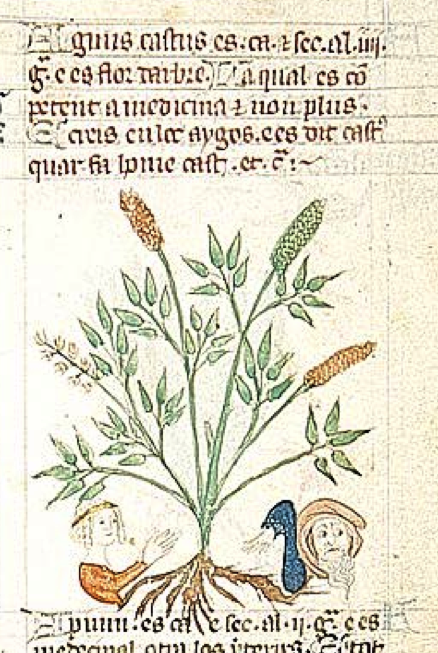 To the right, on page 11, is a plant clearly labeled Agnus castus (Vitex agnus-castus), a name found in many herbal compendia. It’s an attractive shrubby tree with long lilac-colored spikes.
To the right, on page 11, is a plant clearly labeled Agnus castus (Vitex agnus-castus), a name found in many herbal compendia. It’s an attractive shrubby tree with long lilac-colored spikes.
The drawing is quite amusing. On the left is a pretty young damsel extending a friendly hand. On the right, the fellow is turning a shoulder, averting his eyes, and trying to wave her away. The common name for this plant is “chaste tree” as it was believed it could subdue sexual passion. It also earned the name of “monk’s pepper” in religious orders that promoted chastity.
Most of the mnemonic figures in Palatino 586 are not found in other manuscripts with similarly drawn plants—they are unique to this codex.
Page 12 Lower Left
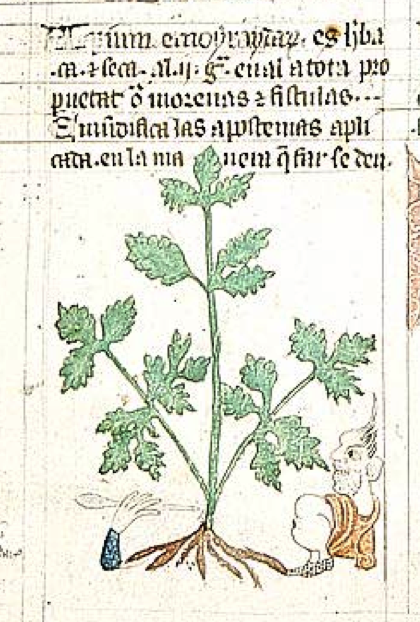 The name Apium emoyraydarum/hemorodarum is obsolete but Apium (usually A. graveolens) is historically used as a food, flavoring, and treatment for hemorrhoids and fistulas. Knights in armor frequently suffered various forms of sores and abscesses in the groin from long chafing horseback rides.
The name Apium emoyraydarum/hemorodarum is obsolete but Apium (usually A. graveolens) is historically used as a food, flavoring, and treatment for hemorrhoids and fistulas. Knights in armor frequently suffered various forms of sores and abscesses in the groin from long chafing horseback rides.
The diagram rather graphically shows a hand with a pointed object (probably a doctor’s hand with a surgical tool) and the patient with his butt and anus exposed. After a fistula was pierced or tied off, a salve that included Apium was used to coat the area to soothe the skin and help prevent infection.
Page 14 Bottom Right
The next image is a bit more challenging to interpret, partly because of the rooster, and partly because scholars long disputed which plant might be the source of the gum called Armoniacus/Ammoniacum.
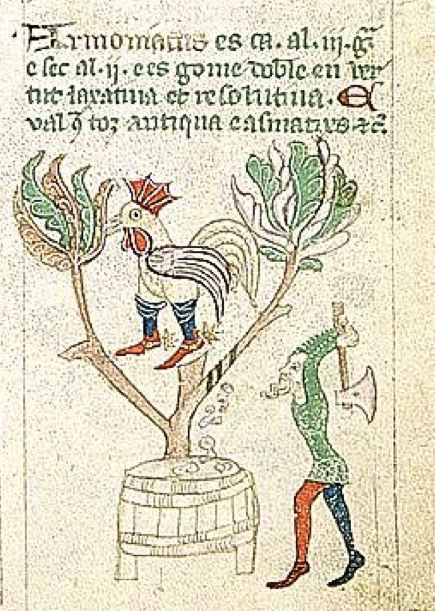 You might notice in the picture that the plant is large, and the fellow with the axe confirms that this was a tree-like herb of considerable size compared to other similar species.
You might notice in the picture that the plant is large, and the fellow with the axe confirms that this was a tree-like herb of considerable size compared to other similar species.
Note the three stripes on one of the branches. Cuts are made to encourage the sap to ooze out and as it dries, it forms lumps of resin which, in this drawing, are collected in a barrel.
There are a number of plants that exude gum from their stalks or roots and asafoetida has already been mentioned on Palatino 586, page 11, so the plant on page 14 is probably one of the Ferulas or fennel plants, several of which were known in the Middle Ages.
So far, so good, but what about the rooster?
The gum resin called ammoniacum is obtained from Dorema ammoniacum (a plant that can grow to nine feet). It was imported from India through Persia, but this form of gum was probably not known in the west in the Middle Ages. Instead, medieval herbals make reference to a gum from Africa. One possibility is Ferula tingitana, a south and east Mediterranean tree-like plant called Giant Fennel, but scholars have long doubted this. In the 18th and 19th centuries they proposed Ferula linkii and Ferula communis as better options. Some even suggested ammoniacum might come from Sylphium, the famous plant on ancient coins that is thought to have gone extinct due to over-harvesting (it was reputed to have chemicals effective for birth control).
The dispute was finally settled (or so they thought) by growing one of the plants in the famous Kew gardens, and waiting until it bloomed to discover its species. The verdict was Ferula communis, a plant that grows in two common forms.
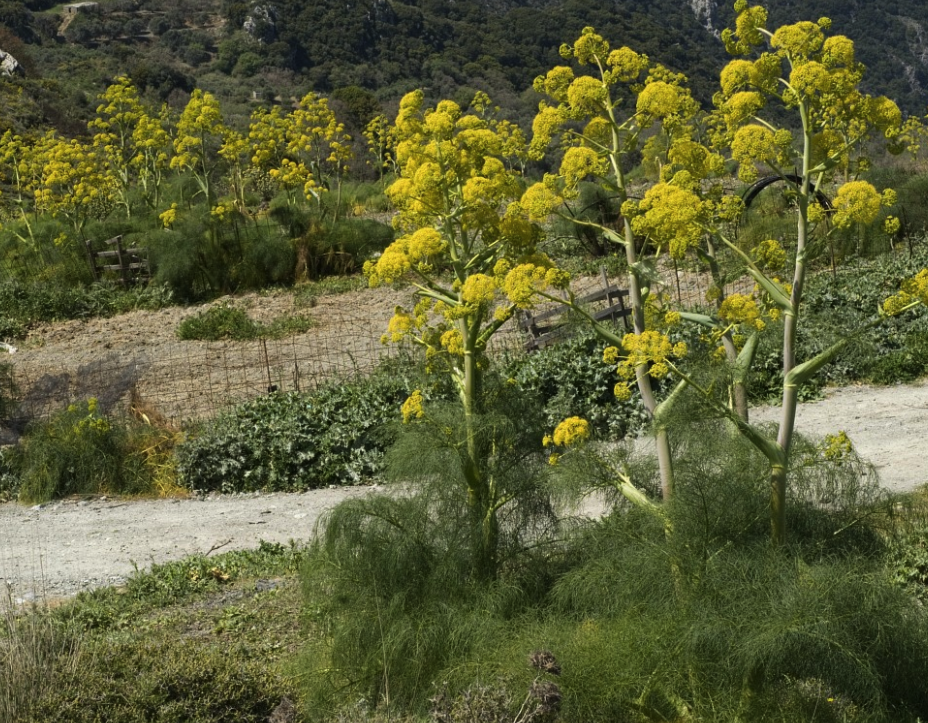
Ferula communis, also known as giant fennel, narthex, or laser, is thought to be the source of gum ammoniac in the Middle Ages. However, some of the ancient herbals indicate another possibility. [Photo credit: Jan van der Straaten]
I haven’t seen anyone else mention this, but if you look at drawings of Ferula in herbal manuscripts, you will notice they are usually drawn like the following examples. Even Palatino 586 includes a plant labeled Ferula that has this form:
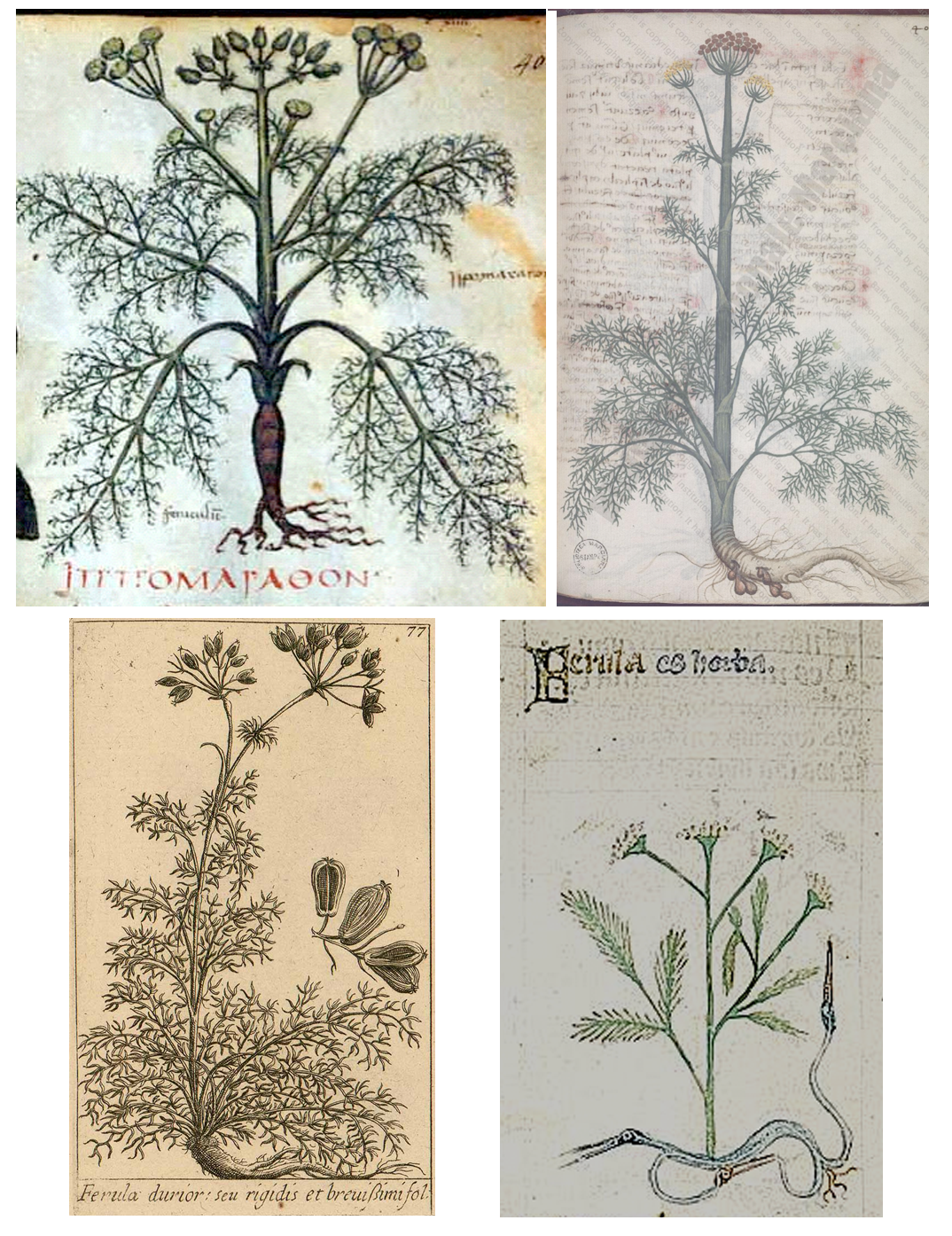 None of these images gives a clue as to why “spurs” are emphasized in Palatino 586, but this one might:
None of these images gives a clue as to why “spurs” are emphasized in Palatino 586, but this one might:
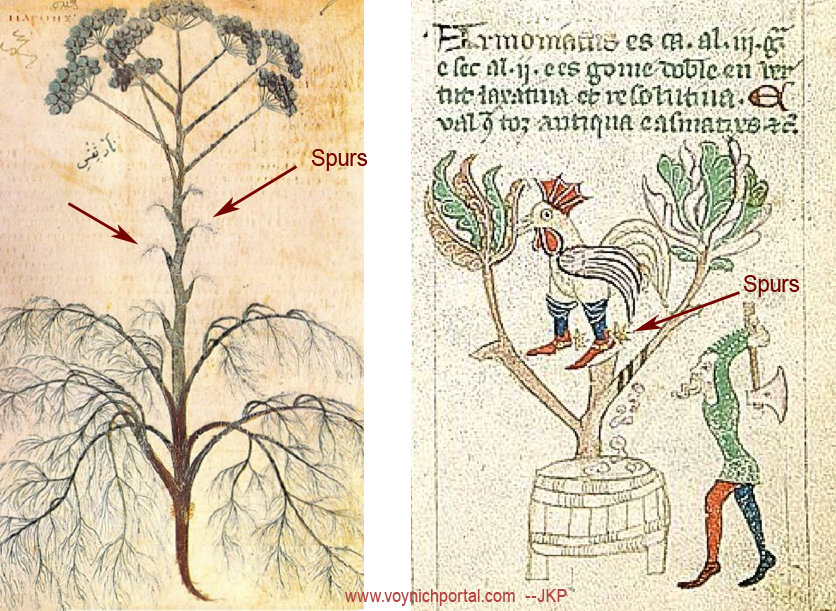 In a previous example, a dog was used to illustrate the use of the plant. In this case, I think the rooster is intended to help the reader identify the plant.
In a previous example, a dog was used to illustrate the use of the plant. In this case, I think the rooster is intended to help the reader identify the plant.
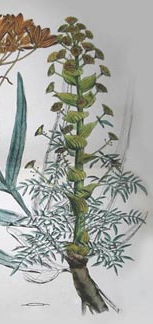 Ferula communis sometimes has spurlike projections, but it’s not a defining characteristic of the plant. Ferula tingitana is more spurlike than F. communis—it has leaf-like projections at the points where the stems branch—but they may not be prominent enough to inspire someone to draw a cowboy-rooster. However, there is another plant that is harvested for gum that is used medicinally that may be intended by these drawings.
Ferula communis sometimes has spurlike projections, but it’s not a defining characteristic of the plant. Ferula tingitana is more spurlike than F. communis—it has leaf-like projections at the points where the stems branch—but they may not be prominent enough to inspire someone to draw a cowboy-rooster. However, there is another plant that is harvested for gum that is used medicinally that may be intended by these drawings.
Ferula narthex (right) is sometimes assumed to be another name for Ferula communis, possibly because the name narthex was loosely applied to many species of Ferula. However, F. narthex is a tall west Asian plant with thick stems that is more upright than F. communis, with very distinctive “spurs” at each node. It was probably known in Europe long before Dorema ammoniacum was imported.
Page 15 Lower Left
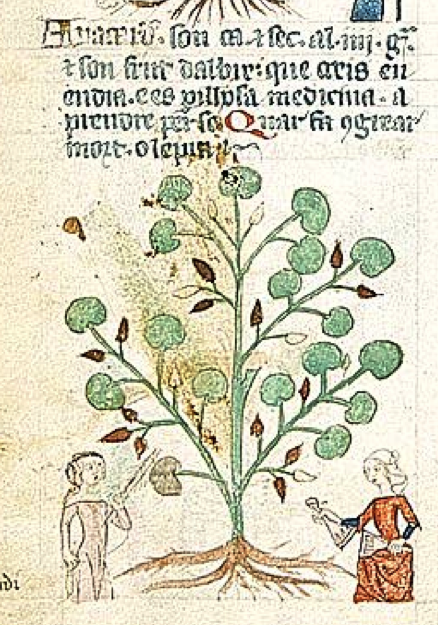 Anacer’u’ on page 15 probably refers to Anacardium and the maiden on the left is using a stick to knock the nuts from the tree. This is not the New World cashew, known as Anacardium orientale, but a cashew-like tree from India (Semecarpus anacardium) that was used for a wide variety of culinary and medicinal purposes. When black, the fruit is toxic, so it is harvested when it is a reddish color. I’m not sure what the maiden on the right is holding—it’s hard to see the details. It might be two bell-like vessels, or two pieces intended to fit together.
Anacer’u’ on page 15 probably refers to Anacardium and the maiden on the left is using a stick to knock the nuts from the tree. This is not the New World cashew, known as Anacardium orientale, but a cashew-like tree from India (Semecarpus anacardium) that was used for a wide variety of culinary and medicinal purposes. When black, the fruit is toxic, so it is harvested when it is a reddish color. I’m not sure what the maiden on the right is holding—it’s hard to see the details. It might be two bell-like vessels, or two pieces intended to fit together.
On page 16, the drawings are quite interesting. On the top left is Amigdale amare—bitter almond, a plant with a toxic seed. There’s a bird from the parrot family top-left, a dog by the base of the tree, and a woman’s face with something streaming out of the tree toward her cheek.
The bird can probably be explained by this Wikipedia photo by Jonathan Cardy, which illustrates the wild parakeet’s fondness for the flowers:
Bitter almond was known to kill dogs, even large dogs, and old medical texts state that the distilled liquid from the seeds produces dizziness, vertigo, and tinnitus in humans, which explains the liquid flowing from the tree to the ear of the woman on the ground.
Page 16 Top-Right
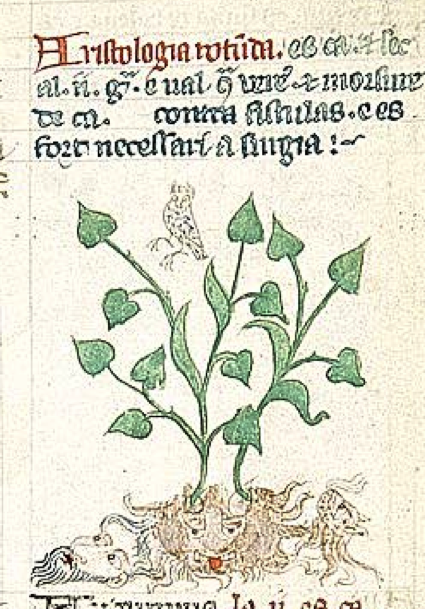 The image to the right also includes a bird at the top and a variety of faces at the bottom. Note that the demon-like face in the middle is somewhat rounded. This is to distinguish Aristolochia rotunda from A. longa, which has a slender root. In Sloane 4016, CLM 28531, and the Carrara herbal, dragons are drawn at the base of the plant, under the root. This is partly to indicate the name of the plant (serpentaria, snakeroot) and partly to indicate its purported use as an antidote to snake poison. It was also known to be toxic, which might explain the demon-like face in the 586 drawing. It is currently believed that aristolochic acid might contribute to kidney and bladder problems.
The image to the right also includes a bird at the top and a variety of faces at the bottom. Note that the demon-like face in the middle is somewhat rounded. This is to distinguish Aristolochia rotunda from A. longa, which has a slender root. In Sloane 4016, CLM 28531, and the Carrara herbal, dragons are drawn at the base of the plant, under the root. This is partly to indicate the name of the plant (serpentaria, snakeroot) and partly to indicate its purported use as an antidote to snake poison. It was also known to be toxic, which might explain the demon-like face in the 586 drawing. It is currently believed that aristolochic acid might contribute to kidney and bladder problems.
I don’t know whether they knew this by observation in the Middle Ages, but insects that eat the leaves of Aristolochia are injesting “chemical armor” that makes them toxic to birds.
The face on the bottom left presents a bit of a puzzle but maybe this is Aristotle providing a mnemonic for the name of the plant.
I can’t explain the catlike face on the right, with something like breath coming out of its nose, but perhaps it’s related to the smell of the plant. Aristolochia uses scent mimicry to lure pollinators, but it’s doubtful this was known in medieval times.
Page 22 Upper Right
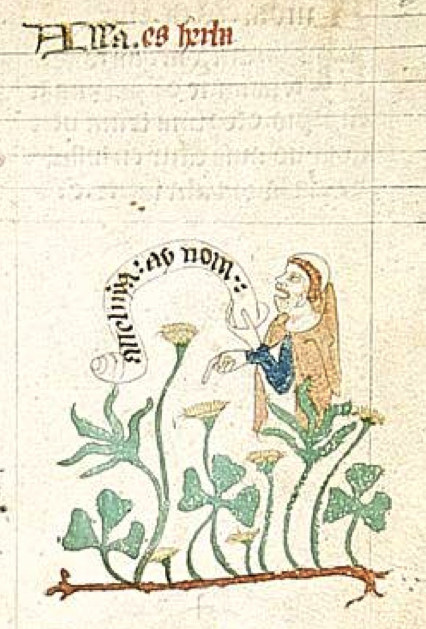 The text for the drawing on page 22 is incomplete, it says only Alla. es herba, but the drawing is accurate and one can immediately recognize the plant as Oxalis acetosella, plus, the figural drawing confirms this. We see a man dressed in monk’s robes holding a scroll on which is written “alleluya…” which is the common name for this plant and a word used in hymns. Note the rounded shape from which the scroll is emanating—it may represent the mouth of a singer or a horn, and the man’s head is thrown back with his mouth wide open.
The text for the drawing on page 22 is incomplete, it says only Alla. es herba, but the drawing is accurate and one can immediately recognize the plant as Oxalis acetosella, plus, the figural drawing confirms this. We see a man dressed in monk’s robes holding a scroll on which is written “alleluya…” which is the common name for this plant and a word used in hymns. Note the rounded shape from which the scroll is emanating—it may represent the mouth of a singer or a horn, and the man’s head is thrown back with his mouth wide open.
Note how the rhizome (side-growing root) is drawn. I have Oxalis in my garden in a shady spot where almost nothing else will grow and it spreads quite rapidly through rhizomes, and yet the Manfredus and Carrara herbals, Sloane 4016, Morgan M.873, and Harley 3736 (to give a few examples), show only a basic root. Probably the best-known herbal that includes the rhizome is Egerton 747 (ca 1295).
Page 25 Upper-Right
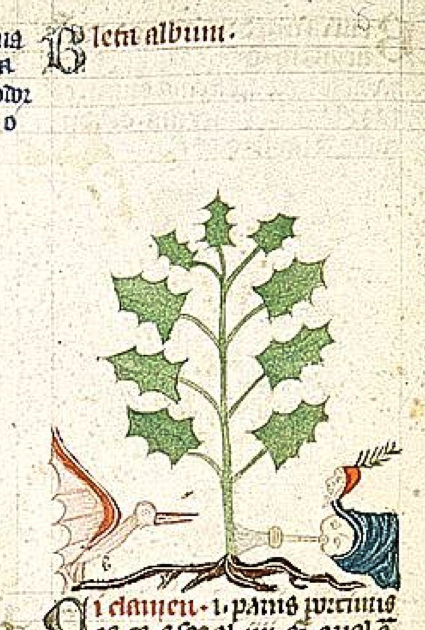 This is an interesting drawing with a bird on the left and a double-headed figure on the right with something horn-shaped by his mouth. It is labeled Bleta album.
This is an interesting drawing with a bird on the left and a double-headed figure on the right with something horn-shaped by his mouth. It is labeled Bleta album.
Bleta refers to leaf and is usually associated with various forms of spinach and beet plants, valued for their edible leaves. However, this is obviously not chard, which has a mass of broad leaves growing low to the ground rather than jaggy leaves growing up the stalk. There are other forms, such as Bleta trigyna, that grow in this fashion.
Blitum bonus-henricus looks like this drawing when it is flattened and dried, the ruffled leaves taking on a more spiky appearance, and is commonly known as Good King Henry or Poor man’s asparagus. This is not based on an English king, however, it apparently comes from Heinrich which may, in turn stem from Old High German Heimrih (home ruler).
I’m not completely sure of the meaning of this drawing, but if the plant is Good King Henry, then perhaps the two-headed figure on the right is a troubadour with an extra head on his jester’s hat. Troubadours were performers skilled in puppeteering, acrobatics, juggling, clowning, and music—circus performers who were sometimes under the patronage of a ruler or noble house.
If the object in his mouth is a wind instrument, then it would fit with a king’s court filled with entertainers, and would evoke the name of the plant. It’s possible the bird is included because the seeds of the chenopods are very popular with birds. I’m not sure, however, since the seed tassels are not shown (perhaps because they are not the part of the plant that is used by humans).
On page 26 top-left, we see a woman wielding a broom, a common use for Bruscus ruscus. For page 28 lower-right, read the story about castoreum on a previous blog.
This is becoming long, so I’ll conclude with just one more…
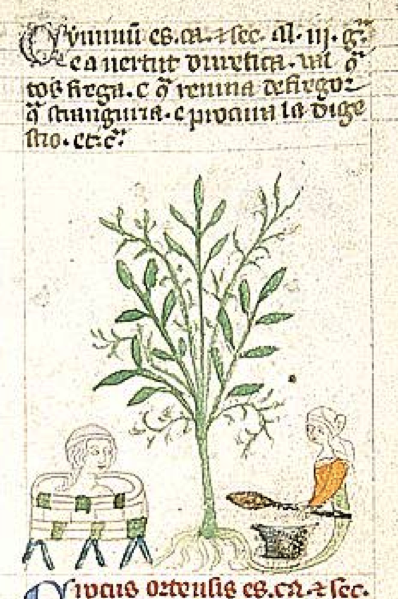 The drawing on page 30 (left) might interest Voynich researchers because there’s a bath, but to understand what’s going on, one has to identify the plant. I’m fairly certain this is Cuminum cyminum (caraway).
The drawing on page 30 (left) might interest Voynich researchers because there’s a bath, but to understand what’s going on, one has to identify the plant. I’m fairly certain this is Cuminum cyminum (caraway).
Cyminum was used as a relaxant and soother of swollen bronchial tubes, so imagine that you’re sick with a bad cold and you treat it with a nice hot bath and a steam-pot full of herbs to help clear your sinuses.
The picture on the right might not be a steam pot. It looks like she is holding a spoon, so perhaps the drawing on the left indicates the relaxant properties and the one on the right illustrates the plant’s use as a digestive aid.
Summary
This is just a small selection of examples, there are approximately 300 individual figures associated with plants on the first 60 pages so it’s not possible to cover more than a tiny percentage in one blog, but it should be enough to illustrate that the figures serve a variety of purposes—sometimes indicating the use of the plant, sometimes physical properties that set it apart from similar species, and sometimes the name.
J.K. Petersen
Copyright © 2018 All Rights Reserved, J.K. Petersen

